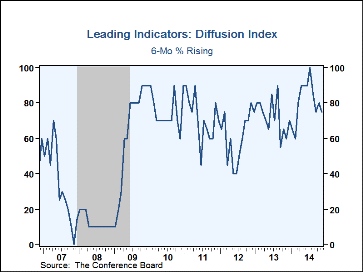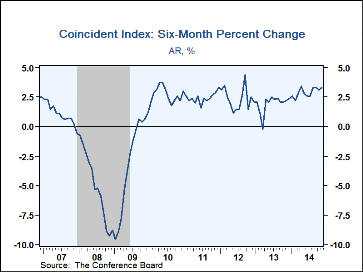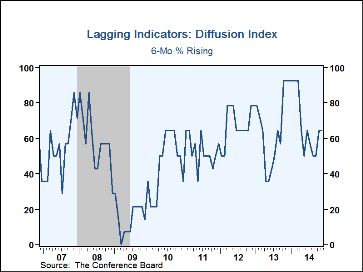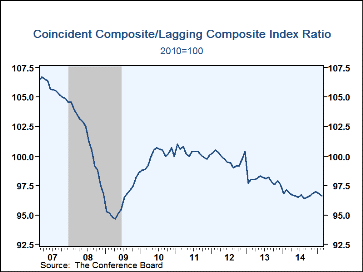 Global| Mar 19 2015
Global| Mar 19 2015U.S. Leading Economic Indicators Increase but Forward Momentum Slows
by:Tom Moeller
|in:Economy in Brief
Summary
The Index of Leading Economic Indicators from the Conference Board increased 0.2% (6.2% y/y) during February following an unrevised 0.2% January improvement. A 0.2% rise had been expected in the Action Economics Forecast Survey. The [...]
The Index of Leading Economic Indicators from the Conference Board increased 0.2% (6.2% y/y) during February following an unrevised 0.2% January improvement. A 0.2% rise had been expected in the Action Economics Forecast Survey. The increase lowered three-month growth to 3.7% (AR), its weakest in twelve months. Seventy percent of the component series improved m/m, down a bit from the recent highest breadth of increase. A steeper interest rate yield curve, higher stock prices, more building permits, improved consumer expectations for business/economic conditions and the leading credit index led last month's index higher. Other component series improved, but the contributions from unemployment insurance claims, ISM new orders and the average workweek were negative.
The index of coincident indicators gained 0.2% (3.0% y/y), the same as in January. Three-month growth, however, declined to 2.5%, its weakest since October. Each of the four component series increased last month, including nonfarm payroll employment, personal income less transfers, business sales and industrial production.
The lagging indicators index increased 0.3% (3.5% y/y), the same as in January. During the last three months, growth of 3.5% was up from 2.1% in December, suggesting a modest buildup of economic excess. The duration of unemployment, more C&I loans outstanding and a higher consumer installment credit/personal income ratio accounted for much of last month's increase.
The index of coincident-to-lagging indicators is a measure of how the economy is performing versus its excesses. It slipped for the second straight month but remained up from the cycle-low.
The Conference Board figures are available in Haver's BCI database; the components are available there, and most are also in USECON. The forecast figures for the Consensus are in the AS1REPNA database. Visit the Conference Board's site for coverage of leading indicator series from around the world.
| Business Cycle Indicators (%) | Feb | Jan | Dec | Y/Y | 2014 | 2013 | 2012 |
|---|---|---|---|---|---|---|---|
| Leading | 0.2 | 0.2 | 0.4 | 6.2 | 5.8 | 3.3 | 2.1 |
| Coincident | 0.2 | 0.2 | 0.3 | 3.0 | 2.5 | 1.9 | 2.6 |
| Lagging | 0.3 | 0.3 | 0.2 | 3.5 | 3.8 | 3.8 | 3.1 |
Tom Moeller
AuthorMore in Author Profile »Prior to joining Haver Analytics in 2000, Mr. Moeller worked as the Economist at Chancellor Capital Management from 1985 to 1999. There, he developed comprehensive economic forecasts and interpreted economic data for equity and fixed income portfolio managers. Also at Chancellor, Mr. Moeller worked as an equity analyst and was responsible for researching and rating companies in the economically sensitive automobile and housing industries for investment in Chancellor’s equity portfolio. Prior to joining Chancellor, Mr. Moeller was an Economist at Citibank from 1979 to 1984. He also analyzed pricing behavior in the metals industry for the Council on Wage and Price Stability in Washington, D.C. In 1999, Mr. Moeller received the award for most accurate forecast from the Forecasters' Club of New York. From 1990 to 1992 he was President of the New York Association for Business Economists. Mr. Moeller earned an M.B.A. in Finance from Fordham University, where he graduated in 1987. He holds a Bachelor of Arts in Economics from George Washington University.










